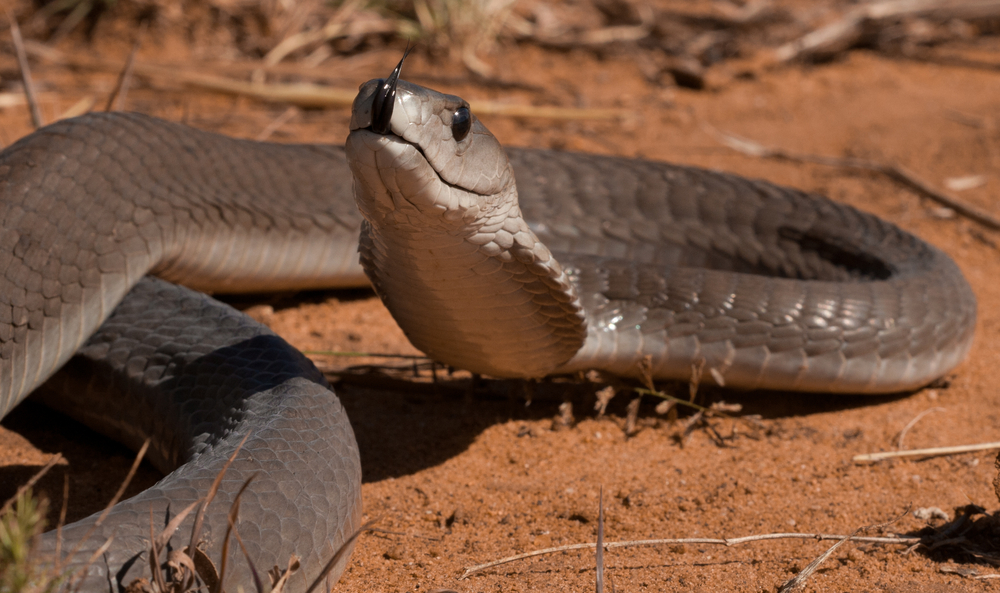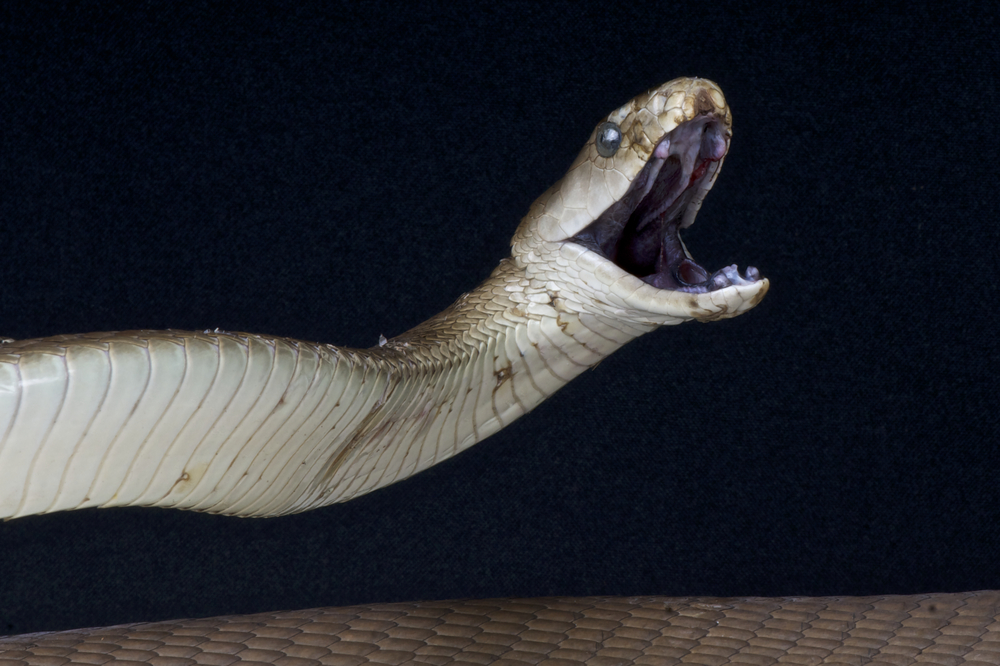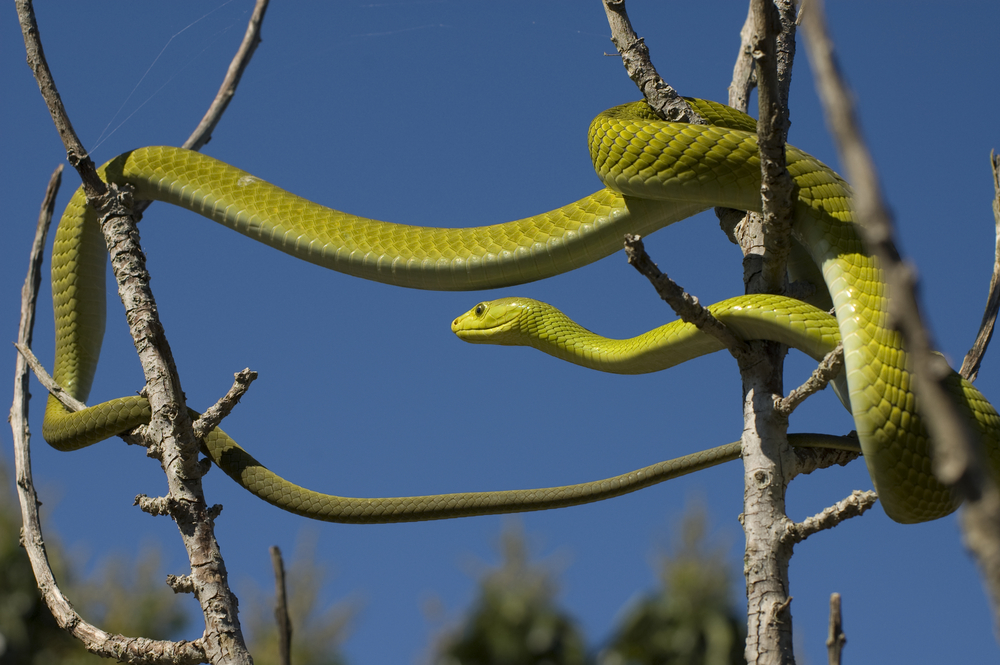Black Mamba Facts

The black mamba has quite a reputation. It is one of the world’s deadliest snakes. It is the fastest land snake in the world, and “the longest species of venomous snake in Africa and the second longest in the world,” said Sara Viernum, a herpetologist based in Madison, Wisconsin. This snake’s potential danger has been the subject of many African myths and it has been blamed for thousands of human deaths.
The black mamba's reputation is not undeserved. “Black mambas are extremely toxic and very fast snakes,” Viernum said. They are highly aggressive when threatened, “known to strike repeatedly and [to] inject a large volume of venom with each strike.” Their venom is potentially lethal, and though antivenin exists, it is not widely available in the black mamba’s native habitat of southern and eastern Africa. For this reason, they are considered a top killer in a land where nearly 20,000 people die from snake bites every year, according to PBS’s Nature.
Characteristics
Contrary to what its name would suggest, black mambas are actually brownish in color, ranging from olive to greyish tones, with paler bellies. “They are named for the coloration of the inside of their mouths, which is a deep, inky black,” explained Viernum. “Similar to cottonmouths, when threatened a mamba will open its mouth to show the black lining as a warning signal.”
Black mambas have coffin-shaped heads and are lithe, athletic snakes. According to National Geographic, they can grow to be 14 feet long (4.25 meters), though their average length is around 8 feet (2.4 m). These giants can live up to 11 years in the wild.

Habitat
Black mambas reside in South and East Africa’s savannas, rocky hills and open woodlands, according to the University of Michigan Museum of Zoology’s Animal Diversity Web (ADW). They like low, open spaces and enjoy sleeping in hollow trees, rock crevices, burrows, or empty termite mounds.
Habits
These speedy serpents can move faster than most people can run, a fact that partly explains why they are so feared. Viernum said, “Black mambas are one of the fastest species of snakes, reaching slithering speed up to 12 mph [19 kph].” This is undoubtedly fast, but still slower than the myths of them outrunning horses would suggest. Over longer distances, they average about 7 mph (11 kph).
They slither quickly in short bursts over level ground, and can zoom along with about one-third of their bodies off the ground and their heads proudly held high. The black mamba racing along with its head nearly 4 feet (1.2 m) in the air is a terrifying and amazing sight. However, according to National Geographic, black mambas use their incredible speed to escape threats, not to hunt.
Black mambas hunt and are active during the day and return to the same place every night to sleep. According to Widescreen’s ARKive Initiative, they are often seen “basking in the branches of a tree in the early morning” before going hunting. Black mambas are sometimes found in pairs or small groups, though Viernum emphasized their fundamental shyness. She said that they are “shy and secretive snakes that prefer to escape confrontation.” Nevertheless, “black mambas can become highly aggressive if threatened. Their defensive behavior is their most distinctive behavioral characteristic.
“When threatened with no perceived available escape, these snakes will raise their upper body off the ground to stand erect,” Viernum said. Their front third of their bodies can rise 3 to 4 feet (0.9 to 1.2 m) off the ground. Then, they will “spread their cobra-like neck flaps [and] gape their mouths to expose the black lining.” This is a defensive posture aiming to scare away the threat. If black mambas need to attack to defend themselves, they will “strike repeatedly, potentially deliver large doses of venom with each strike, and hiss loudly.” Then, they’ll slither away as fast as possible.
Black mambas have no specific predators. Their greatest threat is habitat destruction, according to the ARKive.

Diet
Black mambas typically eat small mammals and birds, though according to Blue Planet Biomes, there have been reports of mambas found with whole parrots or full-grown cobras in their stomachs. In his book Black Mambas (Checkerboard, 2006), Adam G. Klein wrote that black mambas hunt by biting their prey and injecting venom, then releasing it. They then follow it until it becomes paralyzed or dies, at which point they eat it. It doesn’t usually take prey very long to die after being bitten by a black mamba. Black mambas devour their food whole. They have flexible jaws that they can dislocate in order to fit food up to four times the size of their head into their mouth.
Reproduction
According to the University of Wisconsin-La Crosse’s BioWeb, black mambas usually mate during the spring or summer. Males fight for the affections of females. After mating, females lay between 6 to 25 eggs in a damp, warm burrow. The female leaves her eggs and never sees them again. Babies hatch about three months later and are born measuring between 16 and 24 inches.
Bite
Just two drops of potent black mamba venom can kill a human, according to South Africa’s Kruger National Park. “Like cobras and coral snakes, the venom of a black mamba contains neurotoxins,” Viernum told Live Science. She described the venom as “fast-acting.” It shuts down the nervous system and paralyzes victims, and without antivenom, the fatality rate from a black mamba bite is 100 percent. “Fatalities from black mamba bites have been documented to occur within as little as 20 minutes after injection,” said Viernum. “However, most known fatalities have occurred within 30 minutes to 3 hours or longer.”
Taxonomy/classification
The black mamba is one of four species of mambas, according to the Integrated Taxonomic Information System (ITIS). Others are Jameson’s mamba, eastern green mamba and western green mamba. Mambas are in the same family, Elapidae, as coral snakes and cobras. Mambas are slender, agile and active, with smooth scales and powerful venom. They all live throughout sub-Saharan Africa.
According to ITIS, the taxonomy of mambas is:
- Kingdom: Animalia
- Subkingdom: Bilateria
- Infrakingdom: Deuterostomia
- Phylum: Chordata
- Subphylum: Vertebrata
- Infraphylum: Gnathostomata
- Superclass: Tetrapoda
- Class: Reptilia
- Order: Squamata
- Suborder: Serpentes
- Infraorder: Alethinophidia
- Family: Elapidae
- Genus: Dendroaspis
- Species: Dendroaspis angusticeps (Eastern green mamba), Dendroaspis jamesoni (Jameson's mamba), Dendroaspis polylepis (black mamba), Dendroaspis viridis (West African green mamba)
Other mambas
The other mamba species are all smaller and slightly less venomous than the black mamba, though still very poisonous. These snakes are all brilliant green. They are also all arboreal species, residing in trees. They are known to drop from branches onto their prey below. All are solitary snakes.
Jameson’s mamba
This is a slender snake that lives in trees and actively and speedily pursues its small animal prey during the day, according to the Cincinnati Zoo. It can grow up to 8 feet long (2.4 m) and lives in West and Central Africa.
Eastern green mamba
This is the smallest mamba, usually measuring about 6 or 7 feet (1.8 to 2.1 m), according to Reptiles Magazine. It is common in the forests throughout East Africa.
West African green mamba
Also known as the Western green Mamba or Hallowell’s green mamba, this snake can reach 10 feet (3 m), according to Branson’s Wild World. It is the second-longest venomous snake in Africa, after the black mamba. As its name suggests, it lives in West Africa.
Additional resources
Sign up for the Live Science daily newsletter now
Get the world’s most fascinating discoveries delivered straight to your inbox.
Jessie Szalay is a contributing writer to FSR Magazine. Prior to writing for Live Science, she was an editor at Living Social. She holds an MFA in nonfiction writing from George Mason University and a bachelor's degree in sociology from Kenyon College.










